Atmospheric characterization of transiting exoplanets
Previous posts on this blog have discussed different methods for detecting exoplanets, including my favorite, the transit method. Transiting exoplanets, which pass directly in front of their host stars as seen from Earth, are particularly exciting because we can learn a lot more about them than other exoplanets. We can directly measure their size with the transit depth, or in other words, by how much light they block. And the duration of the transit constrains the inclination of the exoplanet’s orbit which, combined with radial velocity measurements, gives us its mass. These parameters combined determine its density, which gives us a sense of whether we’re looking at a rocky or gaseous world.
But for many exoplanets, just having the bulk density isn’t enough to determine their composition. For intermediate-mass exoplanets between the size of Earth and Neptune, many different combinations of rocky, icy, and gaseous materials can explain the bulk density equally well. To pin down the nature of these worlds, we need to study their atmospheres. We can do this with the technique of transmission spectroscopy, in which we observe exoplanet transits at multiple wavelengths and look for spectral regions where the transit depth is larger due to scattering or absorption by atoms and molecules in the upper atmosphere of the exoplanet. If the transit depth is larger around the 1.4 µm water molecular absorption band, for example, that tells us that the exoplanet has water in its atmosphere that is blocking starlight from reaching us. This information about the chemical composition of the exoplanet’s atmosphere narrows the possible range of its bulk composition.
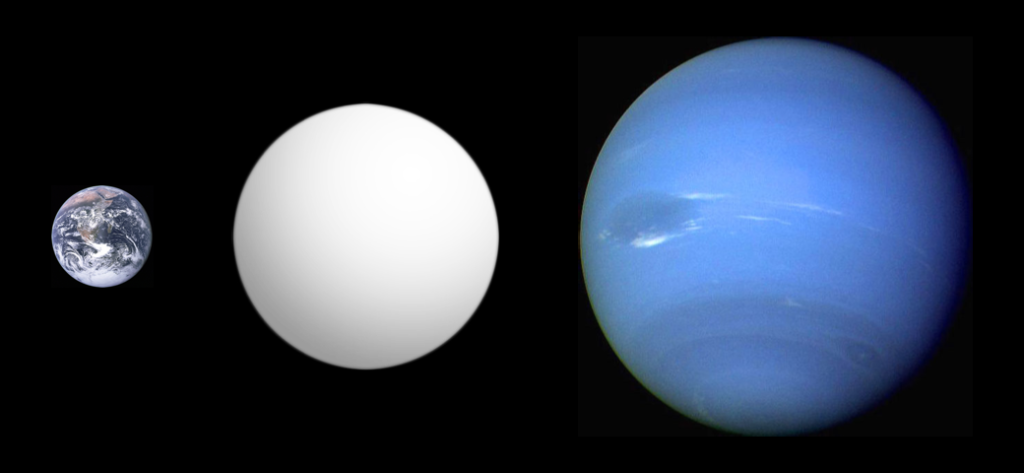
A comparison of Earth (left), Neptune (right), and a typical exoplanet (center). Most exoplanets are between Earth and Neptune in size, and their masses and radii are consistent with a wide range of bulk compositions. Credit: Wikimedia Commons / User:Aldaron
The sub-Neptune GJ 1214b
One of our best opportunities to study an exoplanet atmosphere comes from the sub-Neptune GJ 1214b. With a mass of 6.6 Earth masses and a radius of 2.7 Earth radii, GJ 1214b is squarely between the terrestrial planets and ice giants of the Solar System in terms of size and density, making it an interesting target for studying intermediate-mass exoplanets. It orbits a relatively small mid-M dwarf star (GJ 1214), which means it produces a large transit depth for its size, comparable to that of a hot Jupiter orbiting a Sun-like star. And since its host star is only 15 parsecs away—about 25 times closer than the typical exoplanet-hosting star discovered by the Kepler Mission—it is much brighter than the typical Kepler target, which enables more precise measurements of the transit depth.

An artist’s impressions of GJ 1214b transiting its mid-M dwarf host star. The dark regions are starspots and the bright ones are faculae. Credit: ESO/L. Calçada
Previous measurements from the Hubble Space Telescope have found a flat near-infrared transmission spectrum for GJ 1214b. Modeling efforts show that the lack of any observable molecular features is best explained by either a high-altitude haze or cloud layer in the exoplanet’s atmosphere. In effect, this opacity source prevents from studying deeper layers of the atmosphere. However, we can still learn about the exoplanet’s atmosphere with measurements at optical wavelengths, where Rayleigh scattering from the uppermost layers of the atmosphere can make the exoplanet appear larger at bluer wavelengths. This effect depends on the mean molecular mass of the scattering particle, so optical observations of the Rayleigh scattering slope can place constraints on mean molecular mass of the exoplanet’s atmosphere, which in turn can tell us about the bulk composition of the exoplanet.
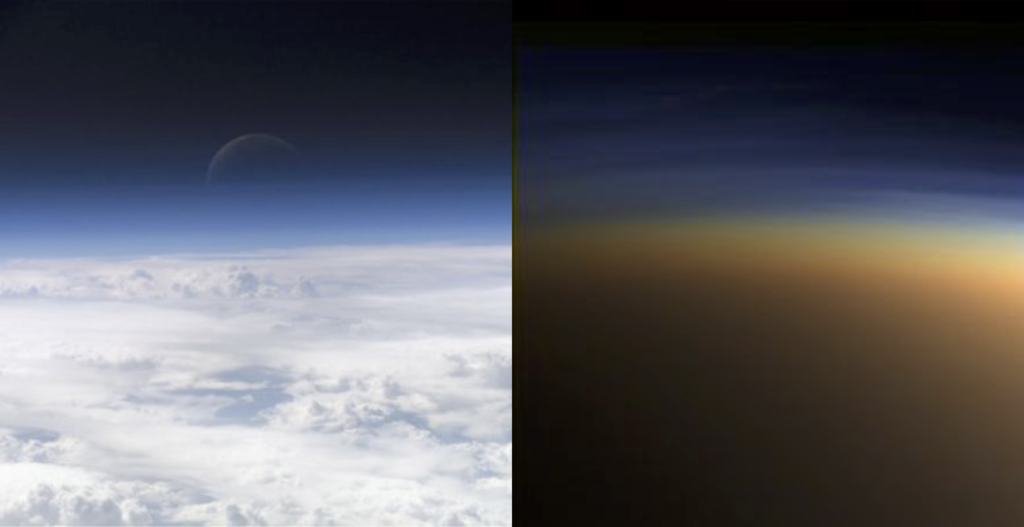
Two Solar System examples of opaque layers in atmospheres. Earth (left) has water clouds that can prevent viewing of the deeper atmosphere, and Titan (right) has a thick photochemical haze that has the same effect. In both cases, Rayleigh scattering in the upper atmosphere above the opaque layer is apparent as a blue glow. Credit: Wikimedia Commons
Observations with Magellan/IMACS
Motivated by this, members of the EOS team set out to measure the transmission spectrum of GJ 1214b across the optical wavelength regime. Our results are published in a recent paper in the Astrophysical Journal. Even though GJ 1214 is a relatively bright star, M-dwarfs are much fainter in the optical than the near-infrared, so we needed “bigger glass” than the Hubble Space Telescope to collect enough photons for this measurement. We turned to the 6.5-meter Magellan Baade Telescope at Las Campanas Observatory in Chile. We used the IMACS multi-object spectrograph on Magellan to collect a time-series of optical (4,500–9,260 Å) spectra of the host star and a handful of comparison stars simultaneously during a transit of the exoplanet. The spectra of the comparison stars allowed us to remove the effects of systematic noise sources introduced by observing conditions in Earth’s atmosphere or the instrument itself, revealing the transit signal in the time-series of GJ 1214 spectra or “light curve.” To make more precise measurements of the transit depth as a function of wavelength, we binned our spectra from their native spectra resolution of R~250 to 14 spectral bins. We repeated this observation for a total of three transits to further boost our signal-to-noise ratio and ensure the repeatability of the measurement.

The twin 6.5-meter Magellan Telescopes at Las Campanas Observatory. We used Magellan Baade (right) for this work. Credit: B. Rackham
The optical transmission spectrum of GJ 1214b
The resulting transmission spectrum is very surprising. We found that the transit depth at the red end of the spectrum is roughly the same as has been measured in the near-infrared but tends to decrease at bluer wavelengths. In effect, the apparent size of the exoplanet is smaller at shorter wavelengths, which is opposite of the expected signal produced by Rayleigh scattering in the upper atmosphere. The spectrum seems to suggest that the atmosphere is less opaque in the optical and light is passing through deeper layers than in the near-infrared. Atmospheric models, however, show that whatever cloud or haze layer is producing the flat near-infrared spectrum should be similarly opaque in the optical. So, at first glance, the optical transmission spectrum of GJ 1214b seems to be inconsistent with all atmospheric models for the exoplanet.
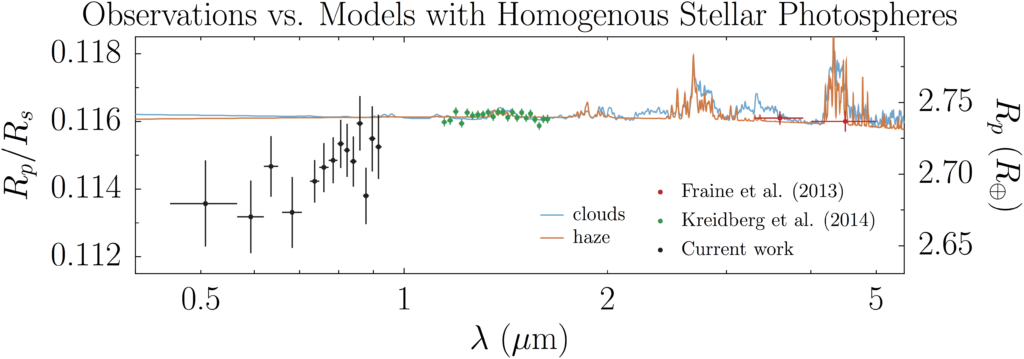
The transmission spectrum of GJ 1214b, or planet-to-star radius ratio derived from the transit depth, is shown as a function of wavelength. The right vertical axis gives the corresponding size of the exoplanet in Earth radii. Our measurements with Magellan/IMACS (black points) are shown along with near-infrared data from the Hubble (green) and Spitzer (red) Space Telescopes. The solid lines are the best-fitting models for cloudy and hazy atmospheres. Adapted from Rackham et al. 2017.
The solution to this problem comes from realizing that the transit depth we observe depends on both the exoplanet atmosphere and the stellar photosphere. The underlying assumption with transmission spectroscopy is that the transit chord does not differ from the rest of the stellar photosphere. Therefore, any changes in transit depth should be due to the exoplanet’s atmosphere blocking photons from reaching us. However, unocculted starspots or faculae can violate this assumption. When photospheric heterogeneities such as these are present, they introduce a systematic difference between the stellar spectrum inside and outside the transit chord. Any difference between the mean stellar spectrum inside and outside the transit chord is imprinted on the transmission spectrum we observe.

We investigate the transmission spectrum produced by the combination of the exoplanet’s atmosphere and the stellar photosphere. In this simple case, the stellar photosphere is comprised of two components with different spectra: a primary component that includes the transit chord and another unocculted component. We find that unocculted stellar faculae covering 3.2% of the stellar disk are the best explanation for the optical spectrum we observe. Credit: B. Rackham
For example, consider the case of unocculted starspots. Being relatively cool, starspots produce few high-energy photons and are therefore faint at blue wavelengths. Their presence makes the unocculted stellar disk fainter on average than the transit chord in the blue optical. So any transiting exoplanet would produce an artificial large transit depth in the blue by blocking the relatively bright transit chord, potentially mimicking the signature of Rayleigh scattering by the exoplanet atmosphere. Unocculted faculae, which are hotter and brighter at short wavelengths, produce the opposite effect and can mask a scattering signature.
Previous studies have relied on monitoring long-term changes in the brightness of the host star to constrain the contribution of unocculted spots to the observed transmission spectrum. Brightness changes, however, can only tell us about inhomogeneities in the stellar photosphere that vary over time. Persistent features, such as polar or latitudinal active regions, won’t contribute to periodic variability but will affect transit measurements.
Considering the contributions of the exoplanet atmosphere and stellar photosphere simultaneously, we found that the transmission spectrum of GJ 1214b is best explained by the combination of two factors: 1) a hazy exoplanet atmosphere that produces a flat transmission spectrum across the optical and near-infrared, and 2) unocculted stellar faculae that produce a decrease in the transmission spectrum at shorter wavelengths. Due to the presence of stellar faculae, it’s not possible to uniquely determine the contribution of Rayleigh scattering to the optical spectrum and therefore pin down the mass of any scattering particle.
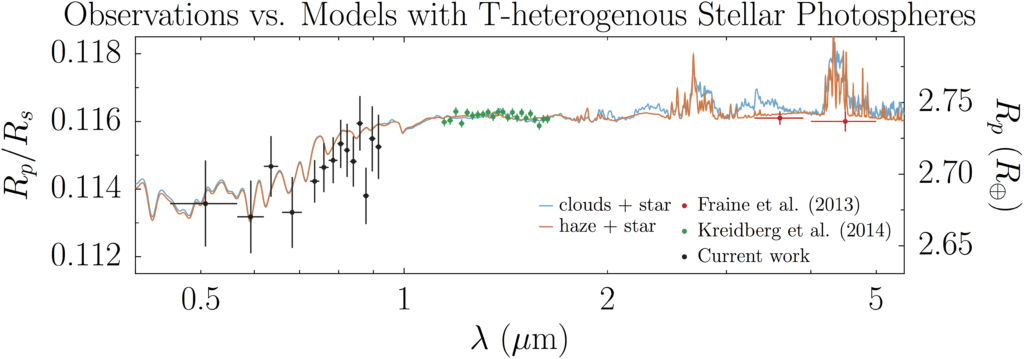
The data are the same as those shown above, but now the models include the effect of a stellar photosphere with unocculted stellar faculae. The bright faculae, which are ~350 K hotter than the remaining photosphere, effectively make the exoplanet appear smaller at optical wavelengths, while having little effect on the near-infrared measurements. Adapted from Rackham et al. 2017.
Looking forward
Our findings show that more work is necessary to understand the effects of persistent photospheric features on exoplanet transmission spectra. This will be very important in the near-term future with the scheduled launch in early 2018 of the Transiting Exoplanet Survey Satellite (TESS), which will discover many interesting low-mass exoplanets around nearby stars. Building upon the Kepler Mission, TESS will be an all-sky survey of bright stars for transiting exoplanets. So unlike the Kepler exoplanets, TESS-discovered exoplanets will orbit host stars that are bright enough to allow for in-depth exoplanet characterization, including searches for potential biosignatures. To ensure stellar photospheres do not mask or mimic spectral features we interpret as biosignatures, it will be necessary to disentangle the stellar and exoplanetary contributions to transmission spectra. On the EOS team, we are currently exploring solutions to this problem, including stellar heterogeneity indicators and transit observations at high-resolution or over a wider spectral range.
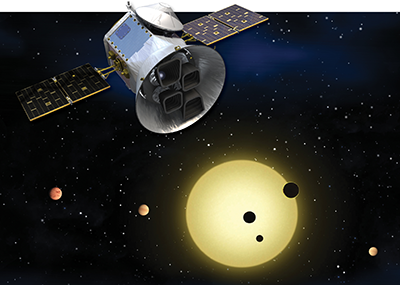
The TESS Mission, scheduled for launch in early 2018, will survey nearby, bright stars and discover thousands of transiting exoplanets, some of which may be suitable hosts for life. Credit: NASA/GSFC
Reference
The full details of this work are published in the Astrophysical Journal: Rackham et al. 2017 ApJ 834, 151.

